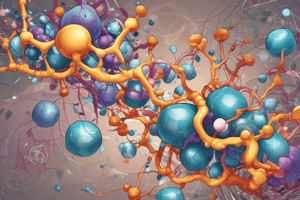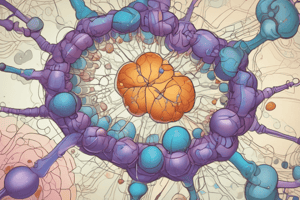Podcast
Questions and Answers
Under what temperature condition can many enzymes in tissues or extracts be preserved for months?
Under what temperature condition can many enzymes in tissues or extracts be preserved for months?
- –20°C or 40°C
- 10°C or 20°C
- 25°C or 37°C
- –20°C or –70°C (correct)
What is the approximate increase in the reaction velocity of most chemical reactions for each 10°C rise in temperature?
What is the approximate increase in the reaction velocity of most chemical reactions for each 10°C rise in temperature?
- It doubles (correct)
- It remains constant
- It increases by 5°C
- It triples
What is the typical optimum temperature range for most body enzymes?
What is the typical optimum temperature range for most body enzymes?
- 30°C to 35°C
- 37°C to 38°C (correct)
- 40°C to 45°C
- 20°C to 25°C
What is the effect of product accumulation on enzyme activity in some enzymatic reactions?
What is the effect of product accumulation on enzyme activity in some enzymatic reactions?
What is the role of activators and coenzymes in enzyme activity?
What is the role of activators and coenzymes in enzyme activity?
What is the effect of time on the rate of an enzyme reaction under optimum conditions of pH and temperature?
What is the effect of time on the rate of an enzyme reaction under optimum conditions of pH and temperature?
What is the effect of physical agents like light rays on certain enzyme reactions?
What is the effect of physical agents like light rays on certain enzyme reactions?
What is the definition of an inhibitor in enzyme reactions?
What is the definition of an inhibitor in enzyme reactions?
What is the effect of ultraviolet rays on the activity of salivary amylase?
What is the effect of ultraviolet rays on the activity of salivary amylase?
What is the purpose of removing products in biological systems?
What is the purpose of removing products in biological systems?
What is the characteristic of a suicide inhibitor?
What is the characteristic of a suicide inhibitor?
What is the effect of aspirin on an enzyme?
What is the effect of aspirin on an enzyme?
What is the mechanism of action of 3-Bromoacetol phosphate (BAP)?
What is the mechanism of action of 3-Bromoacetol phosphate (BAP)?
What is the therapeutic application of disulfiram?
What is the therapeutic application of disulfiram?
What is the characteristic of a substrate analogue inhibitor?
What is the characteristic of a substrate analogue inhibitor?
What is the effect of penicillin on bacterial cells?
What is the effect of penicillin on bacterial cells?
What is the characteristic of an irreversible inhibitor?
What is the characteristic of an irreversible inhibitor?
What is the application of enzyme inhibitors in medicine?
What is the application of enzyme inhibitors in medicine?
What is the primary function of protease enzymes in medical device cleaning?
What is the primary function of protease enzymes in medical device cleaning?
Which enzyme is used to dissolve the hardening of walls of blood vessels?
Which enzyme is used to dissolve the hardening of walls of blood vessels?
What is the benefit of using enzymes to treat disorders?
What is the benefit of using enzymes to treat disorders?
Why are enzymes like Papain administered orally to patients?
Why are enzymes like Papain administered orally to patients?
What is the importance of enzyme inhibitors in elucidating cellular metabolic pathways?
What is the importance of enzyme inhibitors in elucidating cellular metabolic pathways?
What is the purpose of using enzymes in medical device cleaning?
What is the purpose of using enzymes in medical device cleaning?
Which enzymes are used to break down starch and cellulosic polymers?
Which enzymes are used to break down starch and cellulosic polymers?
What is the benefit of using enzymes to treat blood clots?
What is the benefit of using enzymes to treat blood clots?
What is the purpose of using Hyaluronidase in intra-muscular injection forms?
What is the purpose of using Hyaluronidase in intra-muscular injection forms?
Which enzyme is a clinical biomarker for muscle and heart weakness and injury?
Which enzyme is a clinical biomarker for muscle and heart weakness and injury?
What is the purpose of using immobilized enzymes in the manufacture of many drugs and antibiotics?
What is the purpose of using immobilized enzymes in the manufacture of many drugs and antibiotics?
Which enzymes are used in toothpaste to remove stains on teeth?
Which enzymes are used in toothpaste to remove stains on teeth?
What is the purpose of using enzymes in medicine?
What is the purpose of using enzymes in medicine?
Which enzyme is used to break down blood clots?
Which enzyme is used to break down blood clots?
What is the purpose of measuring the amount of certain enzymes in blood?
What is the purpose of measuring the amount of certain enzymes in blood?
Which enzyme is used to make drugs that enhance the body's natural ability to fight blood clots?
Which enzyme is used to make drugs that enhance the body's natural ability to fight blood clots?
Study Notes
Factors Affecting Enzyme Activity
- The following factors affect enzyme activity:
- Substrate concentration
- Enzyme concentration
- pH (H+ ion concentration)
- Temperature
- Product concentration
- Activators and coenzymes
- Time
- Physical agents
- Inhibitors
Effect of Substrate Concentration
- The velocity of the reaction increases with increasing substrate concentration, but eventually reaches a plateau (Vmax)
- At low substrate concentrations, the reaction follows first-order kinetics (V0 increases linearly with substrate concentration)
- At high substrate concentrations, the reaction follows zero-order kinetics (V0 increases by smaller amounts with increasing substrate concentration)
- Km is the Michaelis-Menten constant, which represents the substrate concentration at which the reaction rate is half of Vmax
Effect of Enzyme Concentration
- The velocity of the reaction is directly proportional to the amount of enzyme present, as long as the substrate is not limiting
- The substrate must be present at a concentration sufficient to ensure that all enzyme molecules have substrate bound to their active site
Effect of pH (H+ ion concentration)
- Each enzyme has an optimum pH, at which the enzyme activity is maximum
- Below or above this pH, enzyme activity is decreased
- Optimum pH differs from enzyme to enzyme (e.g., pepsin: 1.2, trypsin: 8.0)
- Changes in pH can alter the ionization state of the amino acid residues in the active site and the substrate
Effect of Temperature
- Enzyme-catalyzed reactions show an increase in rate with increasing temperature, but only within a relatively small and low temperature range
- Each enzyme has an optimum temperature, at which the activity is highest
- The activity progressively declines both above and below this temperature
- Increase in velocity is due to the increase in kinetic energy; further elevation of temperature results in denaturation of the enzyme protein
Effect of Product Accumulation
- Accumulation of products can cause inhibition of enzyme activity for some reactions
- In biological systems, the product is usually removed as it becomes a substrate for a succeeding enzyme in a metabolic pathway
Effect of Activators and Coenzymes
- The activity of many enzymes is dependent on activators (metallic ions) and coenzymes for their optimum activity
- In the absence of these activators and coenzymes, enzymes become functionally inactive
Effect of Time
- Under optimum conditions of pH and temperature, the time required for an enzyme reaction is less
- The time required for the completion of an enzyme reaction increases with changes in temperature and pH from its optimum
Effect of Physical Agents
- Physical agents like light rays can inhibit or accelerate certain enzyme reactions
- For example, the activity of salivary amylase is increased by red and blue light and inhibited by ultraviolet rays
Effect of Inhibitors
- Inhibitors are substances that stop the enzymatic reaction
- Presence of these substances in the reaction medium decreases the rate of enzyme reaction
- Different types of enzyme inhibitors will be discussed separately later
Enzyme Inhibitors
- Enzyme inhibitors are useful in elucidating cellular metabolic pathways and studying metabolic pathways.
- They provide information about substrate specificity of enzymes.
- They are useful for understanding the regulation of enzyme activity within living cells.
- They help in identifying catalytic/functional groups at the active site of enzymes.
Applications of Enzyme Inhibitors in Medicine
Medical Device Cleaning
- Enzymatic detergents are used to clean reusable medical devices.
- Protease and lipase are the two main enzymes used for cleaning medical devices.
- Other enzymes used are amylases and cellulases.
Treatment of Disorders
- Enzymes are used to break internal blood clots, dissolve hardening of blood vessel walls, and promote wound healing.
- Enzymes like serratiopeptidase, trypsin, and chymotrypsin are used to dissolve wound swelling.
Assisting Metabolism
- Enzymes like papain are administered orally to aid digestion in patients with low digestive capacity.
Mechanism-Based Inactivation
- Suicide inhibitors or mechanism-based inactivators are compounds that bind to the active site of an enzyme and permanently block it.
- Examples of mechanism-based inactivators include penicillin, aspirin, and disulfiram.
Clinical Applications of Enzyme Inhibitors
- Enzyme inhibitors have therapeutic applications, and most antibiotics and anticancer drugs are either competitive inhibitors or mechanism-based suicide inhibitors.
Enzymes in Drug Delivery
- Enzymes like hyaluronidase are used to assist drug delivery to the target site.
Enzymes in Diagnosing Disorders
- Enzymes can be used as biomarkers to diagnose disorders, such as creatine kinase for muscle and heart weakness and injury.
Enzymes in Manufacturing Medicines
- Immobilized enzymes are used in the manufacture of many drugs and antibiotics.
- Examples of enzymes used in manufacturing include alpha amylase, lipase, asparaginase, protease, and streptokinase.
Enzymes in Toothpaste
- Enzymes like papain and glucose oxidase are used in toothpaste to remove stains and give white and sparkling teeth.
Studying That Suits You
Use AI to generate personalized quizzes and flashcards to suit your learning preferences.
Description
Learn about the various factors that influence enzyme activity, including substrate concentration, enzyme concentration, pH, temperature, and more.




